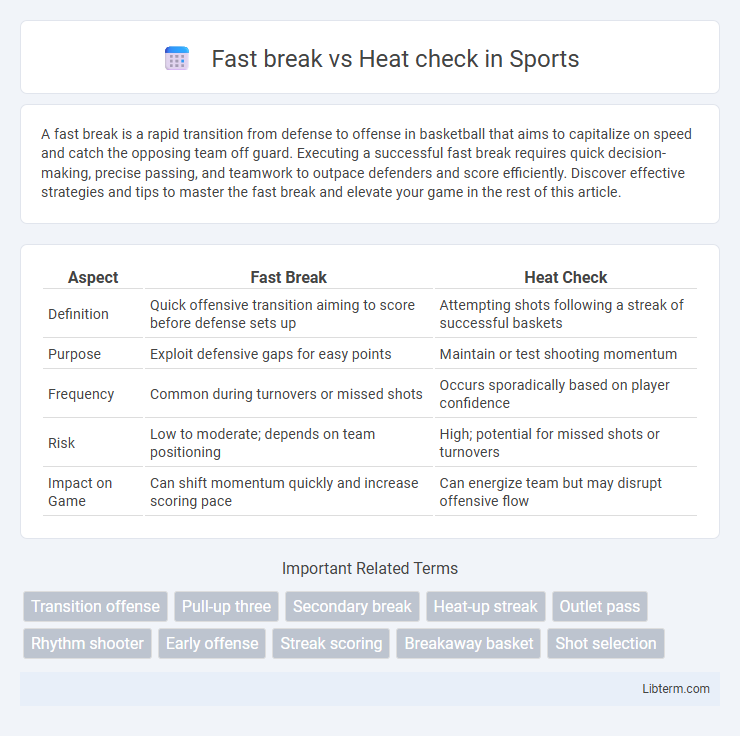A fast break is a rapid transition from defense to offense in basketball that aims to capitalize on speed and catch the opposing team off guard. Executing a successful fast break requires quick decision-making, precise passing, and teamwork to outpace defenders and score efficiently. Discover effective strategies and tips to master the fast break and elevate your game in the rest of this article.
Table of Comparison
| Aspect | Fast Break | Heat Check |
|---|---|---|
| Definition | Quick offensive transition aiming to score before defense sets up | Attempting shots following a streak of successful baskets |
| Purpose | Exploit defensive gaps for easy points | Maintain or test shooting momentum |
| Frequency | Common during turnovers or missed shots | Occurs sporadically based on player confidence |
| Risk | Low to moderate; depends on team positioning | High; potential for missed shots or turnovers |
| Impact on Game | Can shift momentum quickly and increase scoring pace | Can energize team but may disrupt offensive flow |
Understanding the Fast Break in Basketball
The fast break in basketball is a high-speed offensive strategy where a team swiftly moves the ball up the court, capitalizing on opponent defensive gaps before they can set up. This tactic emphasizes quick passing, speed, and court awareness to create open scoring opportunities, often resulting in easy fast-break layups or dunks. Understanding the fast break requires recognizing triggers such as defensive rebounds or steals, which initiate the rapid transition from defense to offense.
Defining the Heat Check Moment
The heat check moment occurs when a player intentionally takes a difficult or deep shot immediately after a string of successful baskets, testing their shooting confidence under pressure. Unlike a fast break, which emphasizes rapid offensive transition and scoring before the defense sets up, a heat check centers on a player's mental challenge to maintain momentum and assert dominance. This moment often defines player aggressiveness and psychological state during critical phases of the game.
Key Differences: Fast Break vs Heat Check
A fast break in basketball is a rapid transition from defense to offense aiming to score quickly before the opposing defense sets up, emphasizing team speed and coordination. A heat check refers to a player's aggressive shooting attempt, often after a series of successful shots, to test if they are "on fire," focusing on individual confidence and momentum. The key difference lies in the fast break being a team strategy for quick scoring, while the heat check is an individual player's psychological and shooting test during a game.
Strategies for Executing a Successful Fast Break
Executing a successful fast break requires quick decision-making, precise passing, and rapid positioning to outpace the defense, capitalizing on transition opportunities before the opposing team sets up. Emphasizing outlet passes and maintaining spacing while sprinting down the court maximizes scoring chances and prevents turnovers. Effective fast break strategies balance speed with control, contrasting the Heat Check's focus on individual shot attempts by prioritizing team coordination and high-percentage finishes.
Recognizing the Right Time for a Heat Check
Mastering the distinction between a fast break and a heat check hinges on recognizing the optimal moment to attempt high-risk, high-reward shots. A heat check typically occurs when a player is on a scoring streak and aims to capitalize on momentum but requires awareness of shot clock and defensive setup to avoid turnovers. Understanding game context, such as team score, momentum shifts, and opponent fatigue, enhances decision-making for when a heat check can positively impact the game's outcome.
Impact of Fast Breaks on Game Momentum
Fast breaks accelerate game momentum by quickly shifting from defense to offense, creating high-percentage scoring opportunities before the opposing team sets up. Teams that effectively execute fast breaks increase transition points, often leading to scoring runs that demoralize opponents and energize teammates. This rapid offensive strategy disrupts defensive rhythm, influencing overall game pace and favoring teams with strong speed and decision-making skills.
Heat Check: Risk and Reward Analysis
Heat check in basketball refers to a player's decision to take risky, high-value shots during a scoring streak, often to capitalize on momentum and boost team morale. This approach carries the reward of potentially increasing the score rapidly and intimidating opponents, but the risk lies in decreased shooting efficiency and disrupting team dynamics if shots consistently miss. Analyzing shot charts and player efficiency ratings reveals that heat checks can lead to temporary scoring surges but often result in lower overall shooting percentages compared to more controlled fast break opportunities.
Role of Team Dynamics in Fast Breaks
Fast breaks rely heavily on seamless team dynamics, where quick decision-making and precise passing create high-percentage scoring opportunities before the defense sets up. Effective communication and spatial awareness among players enable rapid transitions from defense to offense, exploiting numerical advantages. In contrast, heat checks focus on individual scoring confidence rather than cohesive team play, making fast breaks a critical element of team-oriented basketball strategy.
Psychological Aspects of Taking a Heat Check
Taking a heat check in basketball often involves a significant psychological risk as players challenge their confidence and mental toughness by attempting difficult shots to confirm a scoring streak. The decision to take a heat check reflects a player's self-belief and desire to maintain momentum, despite the increased likelihood of missing. This mindset contrasts with fast break scenarios where quick, team-oriented decision-making prioritizes efficiency over individual risk-taking.
When to Prioritize Fast Breaks Over Heat Checks
Prioritize fast breaks over heat checks when your team has a clear numerical advantage or is seeking to capitalize on transition opportunities to score efficiently. Fast breaks maximize scoring potential through quick ball movement and exploiting defensive gaps, while heat checks risk turnovers and low-percentage shots. Coaches often emphasize fast breaks during critical moments to maintain momentum and increase shot quality in high-tempo games.
Fast break Infographic

 libterm.com
libterm.com